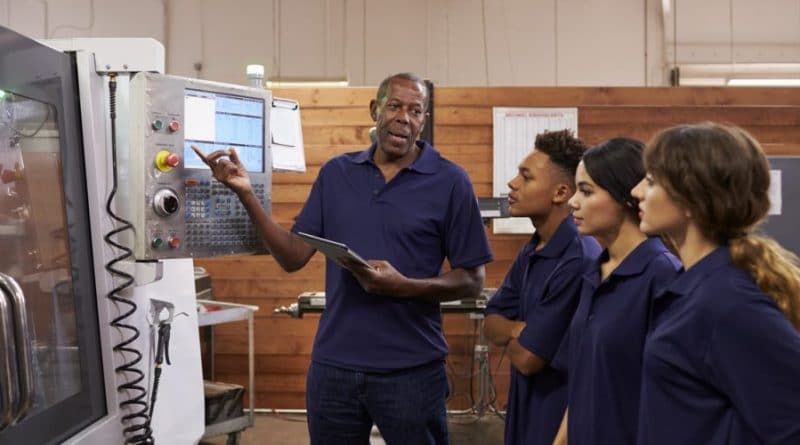The Time Is Now for Conversations Around Workforce Retraining
Source: https://www.roboticsbusinessreview.com
Photo Caption: Katie Stebbins, a speaker at RoboBusiness 2018, urges employers, higher education, and governments to talk about population shifts and demographics and plan for workforce retraining so that employees are helped, not harmed, by robotics and automation.
Conversations around workforce shifts due to robotics and automation need to be less about “the sky is falling” and more about how the country can benefit from workforce retraining as the population shifts geographically and lives longer, said Katie Stebbins, vice president of economic development at the University of Massachusetts.
“Over the next 10 years, labor economists are predicting a drop in population growth due to lower birth rates among millennials,” Stebbins said. “This contraction, combined with an increasing number of jobs in manufacturing, retail, trades, and service that employers can’t fill, means we’re going to have some tasks that will be replaced with automation. Instead of wholesale lamenting automation, we need to talk about how critical it is in some sectors. We simply won’t have enough people to fill the jobs that need to be filled in order to stay productive.”
Katie Stebbins, UMass
Stebbins will speak about issues around workforce retraining as part of a panel at RoboBusiness, to be held Sept. 25-27, 2018, in Santa Clara, Calif. (Robotics Business Review produces RoboBusiness.)
The panel, “Formulating a Workforce Reprogramming Strategy for Your Organization,” is scheduled for 3:15 p.m. on Sept. 26. Scheduled to appear along with Stebbins is Charlene Stokes-Schwartz, executive director of the Human-Machine Social Systems Lab at MITRE; Jeff Burnstein, president of the Association for Advancing Automation (A3); Nancy McIntyre, regional manager at the Robotics Education Foundation; and Natalie Pierce, a shareholder at Littler.
More specific conversations needed
The conversation around jobs and automation tends to fall into a “the sky is falling” mentality, Stebbins said.
We need to apply a fine-toothed comb to the conversation,” she said. “The conversation needs to be nuanced, it needs to have better data coming into it, and we need to be clear about what we’re talking about – because right now, we’re painting such a broad brush on it that it’s creating panic without having an intelligent conversation about the details.”
Workforce retraining conversations are also becoming important at the national level, as unemployment rates are at unprecedented low levels, Stebbins said.
“We can talk about being nervous about what’s going to happen to jobs, but the fact is we also need to have a macro conversation about the survivability of U.S. competitiveness and how automation will be critical to fill in tasks that aren’t going to be performed by people, because we’re going to have [fewer] people,” she said.
For example, population projections indicate that millennials are not having as many children as earlier generations, creating a longer-term labor shortage in the next 10 to 15 years.
“It’s critical that the future work conversation and the automation conversation start to be very honest about population growth,” Stebbins said. “Given the employees we have, what are the tasks that we should be automating, but also what are the tasks that we should be making sure humans can continue to do. That’s an important view because it views humans as a premium, not as something to be replaced.”
Getting people into jobs they like
Another area where a fine-toothed comb approach is needed is helping workers figure out what jobs they really want to pursue and help them find retraining and re-skilling opportunities, Stebbins said. For example, a 2016 report by the Pew Research Center on the state of American jobs reported that only 49% of Americans were very satisfied with their current jobs.
“I think we need to do a better job in this country of matriculating people into careers that help form better identities for their life,” Stebbins said.
A third area where demographics are playing a part is that people are living longer lives, and will likely need to work longer than previous generations.
“When someone is 45 or 50, they may be going back to school and retraining for a new career, because they still have 20 years of work ahead of them,” Stebbins said. “So you could end up having two 20-year careers in completely different fields as the economy changes.”
In addition to workforce retraining, automation policies can include resources such as exoskeletons or other lift-assist devices to help an aging workforce.
Challenges ahead for workforce retraining and reskilling
With employees looking to retrain or add new skills for their careers, higher education will be key to providing the incumbent workforce with opportunities to learn without disrupting their existing jobs or by giving them financial assistance to retrain, Stebbins said.
Mid-career retraining will have older students learning new skills. Source: ClipArt.com
“We should be having the conversation of ‘What does the financial assistance look like?’ to allow an adult to go back and get retrained,” she said.
Stebbins gave an example of a 45-year-old friend who would love to go back to school to get a law degree but is finding it difficult with two children to support, along with a mortgage and other bills. “It’s going to have to be a hand-in-glove relationship between the private sector and public sector to assist older, mid-career adults in retraining and re-skilling,” she said.
Companies also need to adjust some of their attitudes around training opportunities for employees, even if that means potentially losing the employee to a competitor.
“There are companies that say, ‘Hey, we’re a great place to work, I know that the employees are going to want to get retrained and stay here, and we’re going to do everything we can to keep them, we’re willing to take the risk because we’ve got to grow the workforce,” Stebbins said.
She added that companies that have trouble with workforce retraining “really have to dig in and look in the mirror and figure out why people aren’t staying, because there’s probably something going on at the workplace that’s causing employees to turn over quickly. We know that employees tend to leave managers, not jobs.”
Within the higher education space, colleges and universities are already planning for the population shifts, mid-career retraining and other reskilling efforts, Stebbins said. Continuing education and workforce retraining programs are growing across the community college and four-year school landscape, helping not only in the employee training space, but also with returning veterans, for example.
In addition, she said, companies are calling on universities to help them with existing employee training sessions. Trends such as micro-credentialing and lifelong learning are create more opportunities for students to learn new skills.
Best time to talk is now
Fortunately, with the nation’s low unemployment rate, the best time to begin workforce retraining conversations with employers, higher education, and government is now, Stebbins said.
“Let’s temper the ‘sky is falling urgency,’ let’s sit down with cooler heads, and let’s analyze the data around our future labor force against workforce demand so that we’re having a really pragmatic conversation that meets the vision and needs of our country,” she said. “I’m an optimist, so I’m never going to say anything is too late. Nothing’s too late – let’s begin. Whenever we begin is going to be the right time.”



 Stebbins will speak on the panel, “Formulating a Workforce Reprogramming Strategy for Your Organization,” scheduled for Wednesday, Sept. 26, 2018, at 3:15 p.m.
Stebbins will speak on the panel, “Formulating a Workforce Reprogramming Strategy for Your Organization,” scheduled for Wednesday, Sept. 26, 2018, at 3:15 p.m.